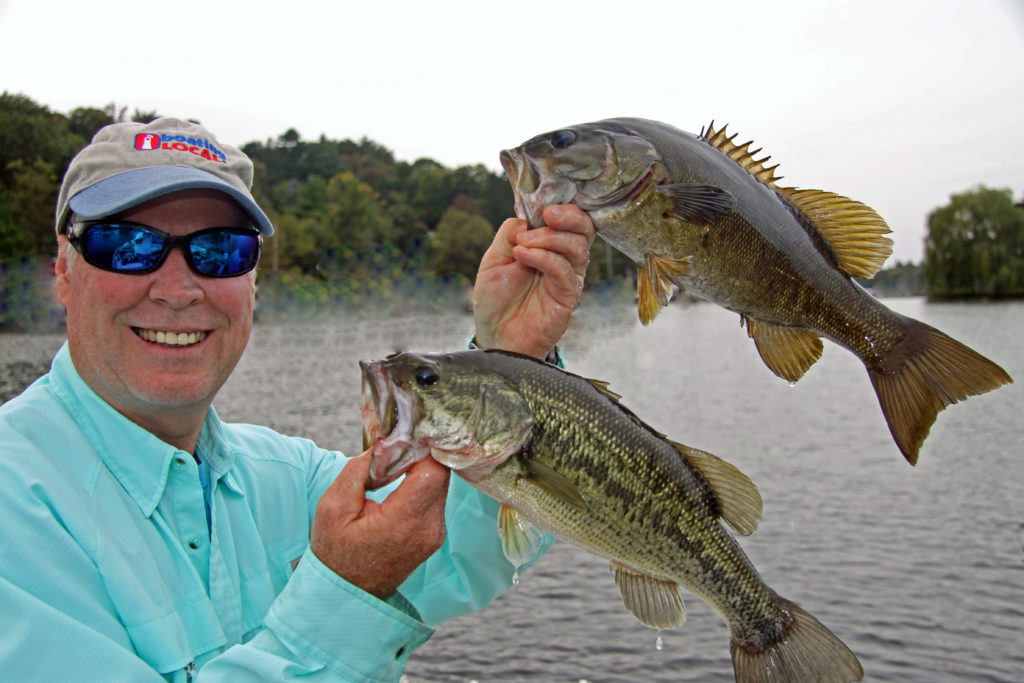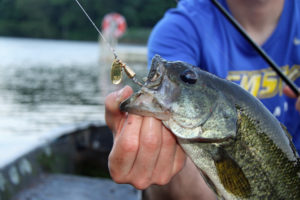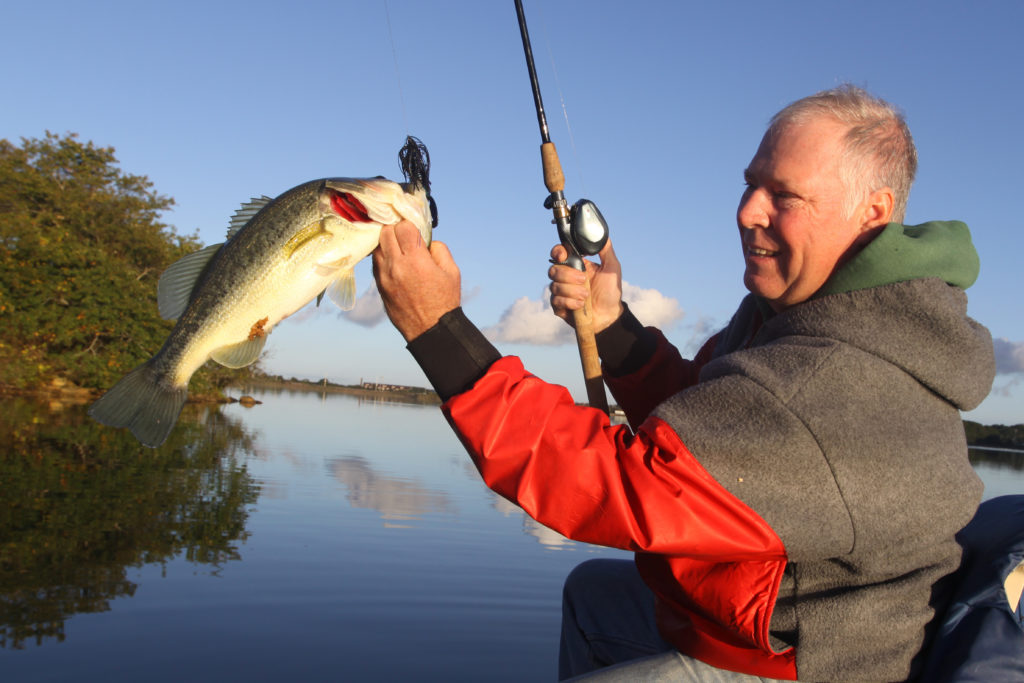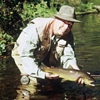FOLLOW-UP ON BLACK BASS

Having a follow-up lure paired to your first choice and ready to go is a sure way to increase your score with bigmouths and bronzebacks. The author took this nice brace of bass at Lake Mahopac, NY. Outdoortom.com photo.
The strike was unmistakable. A lunker largemouth bass had exploded on my Zara Spook as I “walked the dog” along the protruding edge of a small lily patch. Somehow the big fish missed the lure completely, even thought it was in open water. A second cast to the same spot brought a slight swirl, a third cast no movement at all.
With my heart still pounding, I switched rods and tossed a six-inch black plastic worm rigged wacky-style to the lily edge. Instantly, the line twitched and a fat 4-pounder catapulted into the air as the hook stung its jaw.
FOLLOW-UP STRIKES
I call that a follow-up strike. It comes from an aggressive fish that just missed or pulled up short the first time it saw your offering. Often, such fish seem to grow increasingly cautious as you make additional casts. This frequently happens when using surface lures, but you’ll see it with submersibles, too, often as an aggressive wake that simply dissipates just before reaching your spinnerbait or shallow diving plug.
In each of these instances, a bass has proven that it is both present and in a feeding mode. While it may have realized that something wasn’t quite right with your initial offering, it may still be possible to draw an impulse strike by immediately switching to a different lure that contrasts sharply with the original – and the technique works with both bigmouths and bronzebacks.

In-line spinners and Rapala Floating Minnows or Yo-Zuri Crystal Minnows can be a deadly 1-2 punch for wary bass. Photo by Tom Schlichter.

The author used a big black jig with a crayfish trailer to tempt this bass after it swiped and missed a surface lure. Outdoortom.com photo.
CLASSIC COMBOS
Most serious bass fans keep several rods rigged and ready to go so that they can quickly change techniques or work different structure types during the day. With a little planning, you can also rig those extra rods with contrasting lures or colors to increase your percentage of second strikes.
The classic illustration of this idea is use of a slow-sinking soft plastic to follow-up a missed strikes with surface lures. I love tossing yellow Jitterbugs on calm, cloudy mornings, for example. Whenever I set up for such a pattern, however, I also rig a rod with a blue or black soft-plastic crayfish. In this instance, I’m contrasting both the action (fast to slow) and the color (bright to dull). When a big bass misses the surface popper in a violent strike, I follow-up with the soft plastic and a gentle presentation. It’s a deadly change of pace.
Spinnerbaits are another lure style carried by virtually all serious bass fans. On a good day, they can be the best offering in your arsenal. There are times however, especially on a sharply rising barometer, when safety pin lures draw aggressive wakes but few actual strikes.
A follow-up pattern that works well under these circumstances is a three-inch weighted grub in pumpkinseed or watermelon. Simply flip this lure a few feet ahead of where you’ve seen a wake vanish after chasing the spinnerbait, and drag it smoothly and slowly. Bass will often react to this presentation without making an additional wake but leaving no doubt that your grub isn’t going to get away. Strike immediately as your lure stops in its tracks.
DEEP IN THE WEEDS
Bass fans who like to work jig & pigs through heavy slop quickly grow used to missed strikes. It’s just part of the game in this presentation. Go back with a second or third cast and you’ll likely get another strike.
To really put the hammer down on these fish, however, try switching over to a small white or chartreuse tube lure that can punch quickly through heavy cover. Bounce it once or twice on a large lily pad or grass matt, then drop it through the nearest opening. Allow the jig to fall only six to ten inches before forcing it to dangle in place a few seconds with a tantalizing jiggle. If you don’t get smashed, follow-up this retrieve by immediately going back to the jig & pig.
I find it interesting in this follow-up presentation that, although the tube lure will catch its share of fish, it is even better at resetting the scene so that the next time the bass gets a shot at the jig & pig it doesn’t miss. In this instance, then, you are actually using the follow-up to set up a return to the initial offering.
Weedless frogs are another all-time favorite bass lure that can leave anglers wondering how so many fish miss their target. That makes them ideal for working in conjunction with a jig & pig or large weedless worm as the follow-up. In fact, I use the frogs almost like teasers, trying to cover as much water as possible in the hopes that a bass will swirl or bulge the surface, belying its presence. Once I spot such a fish, I’m right on top of it with a pig or 7- to 10-inch plastic worm that I can snake just below the surface. It’s a trick that works more often than not.
Keep in mind that working hard for follow-up strikes calls for keeping that extra rod at arm’s length. It’s important, also, to make the second cast as quickly as possible after the first to keep the bass off guard. Lastly, know that this technique can work very well if fishing with a partner as you can cast opposing lures and follow-up each other’s missed strikes almost instantly. It a fun way to spend a morning, and a great way to experience a truly rewarding sense of teamwork and camaraderie.
By Tom Schlichter
Use the LIKE button below to get notifications about new articles in your Facebook news feed!



